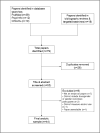Alcohol research with transgender populations: A systematic review and recommendations to strengthen future studies
- PMID: 29571076
- PMCID: PMC5911250
- DOI: 10.1016/j.drugalcdep.2018.01.016
Alcohol research with transgender populations: A systematic review and recommendations to strengthen future studies
Abstract
Background: There is a recent and growing research literature on alcohol use and related harms among transgender and other gender minority populations; however, current definitions and measures of hazardous drinking do not consider the complexity of physiological sex characteristics and socially constructed gender, raising doubts regarding their validity, applicability, and use with these populations. To address this, we reviewed current research on alcohol-related outcomes in transgender populations and critically summarized key issues for consideration in future research.
Methods: We conducted a systematic review of transgender alcohol research in English language, peer-reviewed journals, published 1990-2017, and extracted key details (e.g., sample composition, alcohol measures, results).
Results: Forty-four studies met all inclusion criteria for the review, the majority of which were conducted in the United States. The prevalence of hazardous drinking was high; however, estimates varied widely across studies. We noted frequent methodological weaknesses, including few attempts to differentiate sex and gender, poor attention to appropriate definitions of hazardous drinking, and reliance on cross-sectional study designs and non-probability sampling methods.
Conclusion: Given findings that suggest high need for ongoing public health attention, we offer recommendations to improve future alcohol studies with transgender and other gender minority populations, such as being explicit as to whether and how sex and/or gender are operationalized and relevant for the research question, expanding the repertoire of alcohol measures to include those not contingent on sex or gender, testing the psychometric performance of established screening instruments with transgender populations, and shifting from descriptive to analytic study designs.
Keywords: Alcohol use disorder; Binge drinking; Gender minority; Hazardous drinking; Health disparities; Research methods.
Copyright © 2018 Elsevier B.V. All rights reserved.
Conflict of interest statement
Conflicts of interest: none
Figures
References
-
- Almeida A, Brasileiro A, Costa J, Eusébio M, Fernandes R. Prevalence of and factors mediating HIV infection among sex workers in Lisbon, Portugal: the 5-year experience of a community organization. Sex Transm Infect. 2014;90:497–497. - PubMed
-
- American Psychiatric Association. Diagnostic and Statistical Manual of Mental Disorders. 5th. American Psychiatric Association; Washington DC: 2013. https://dsm.psychiatryonline.org/doi/book/10.1176/appi.books (accessed March 5, 2018) - DOI
-
- American Psychological Association. Guidelines for psychological practice with transgender and gender nonconforming people. Am Psychol. 2015;70:832–864. - PubMed
-
- Berridge V, Herring R, Thom B. Binge drinking: A confused concept and its contemporary history. Soc Hist Med. 2009;22:597–607.
Publication types
MeSH terms
Grants and funding
LinkOut - more resources
Full Text Sources
Other Literature Sources
Medical
Miscellaneous


